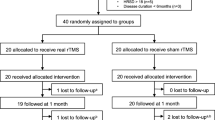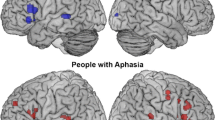Abstract
Repetitive transcranial magnetic stimulation (rTMS) has been used to improve language behavior, including naming, in stroke patients with chronic, nonfluent aphasia. Part 1 of this article reviews functional imaging studies related to language recovery in aphasia. Part 2 reviews the rationale for using rTMS to treat nonfluent aphasia (based on functional imaging) and presents our current rTMS protocol. We present language results from our rTMS studies as well as imaging results from overt naming functional MRI scans obtained before and after a series of rTMS treatments. Part 3 presents results from a pilot study in which rTMS treatments were followed immediately by constraint-induced language therapy. Part 4 reviews our diffusion tensor imaging study examining the possible connectivity of the arcuate fasciculus to different parts of Broca’s area (pars triangularis, pars opercularis) and to the ventral premotor cortex. The potential role of mirror neurons in the right pars opercularis and ventral premotor cortex in aphasia recovery is discussed.
Similar content being viewed by others
References and Recommended Reading
Crosson B, McGregor K, Gopinath KS, et al.: Functional MRI of language in aphasia: a review of the literature and the methodological challenges. Neuropsychol Rev 2007, 17:157–177.
Gold BT, Buckner RL: Common prefrontal regions coactivate with dissociable posterior regions during controlled semantic and phonological tasks. Neuron 2002, 35:803–812.
Price CJ, Crinion J: The latest on functional imaging studies of aphasic stroke. Curr Opin Neurol 2005, 18:429–434.
Thiel A, Habedank B, Herholz K, et al.: From the left to the right: how the brain compensates progressive loss of language function. Brain Lang 2006, 98:57–65.
Pedersen PM, Vinter K, Olsen TS: Aphasia after stroke: type, severity and prognosis. The Copenhagen aphasia study. Cerebrovasc Dis 2004, 17:35–43.
Belin P, Van Eeckhout P, Zilbovicius M, et al.: Recovery from nonfluent aphasia after melodic intonation therapy: a PET study. Neurology 1996, 47:1504–1511.
Rosen HJ, Petersen SE, Linenweber MR, et al.: Neural correlates of recovery from aphasia after damage to left inferior frontal cortex. Neurology 2000, 55:1883–1894.
Naeser MA, Martin PI, Baker EH, et al.: Overt propositional speech in chronic nonfluent aphasia studied with the dynamic susceptibility contrast fMRI method. Neuroimage 2004, 22:29–41.
Martin PI, Naeser MA, Ho M, et al.: Overt naming preand post-TMS: two nonfluent aphasia patients, with and without improved naming post-TMS. Brain Lang 2009 (in press); abstract in Brain Lang 2007, 103:248–249.
Gold BT, Kertesz A: Right hemisphere semantic processing of visual words in an aphasic patient: an fMRI study. Brain Lang 2000, 73:456–465.
Karbe H, Thiel A, Weber-Luxenburger G, et al.: Brain plasticity in poststroke aphasia: what is the contribution of the right hemisphere? Brain Lang 1998, 64:215–230.
Perani D, Cappa SF, Tettamanti M, et al.: A fMRI study of word retrieval in aphasia. Brain Lang 2003, 85:357–368.
Heiss WD, Thiel A: A proposed regional hierarchy in recovery of post-stroke aphasia. Brain Lang 2006, 98:118–123.
Saur D, Lange R, Baumgaertner A, et al.: Dynamics of language reorganization after stroke. Brain 2006, 129:1371–1384.
Hillis AE, Kleinman JT, Newhart M, et al.: Restoring cerebral blood flow reveals neural regions critical for naming. J Neurosci 2006, 26:8069–8073.
Winhuisen L, Thiel A, Schumacher B, et al.: Role of the contralateral inferior frontal gyrus in recovery of language function in poststroke aphasia: a combined repetitive transcranial magnetic stimulation and positron emission tomography study. Stroke 2005, 36:1759–1763.
Maher LM, Kendall D, Swearengin JA, et al.: A pilot study of use-dependent learning in the context of Constraint Induced Language Therapy. J Int Neuropsychol Soc 2006, 12:843–852.
Richter M, Miltner WH, Straube T: Association between therapy outcome and right-hemispheric activation in chronic aphasia. Brain 2008, 131:1391–1401.
Small SL, Flores DK, Noll DC: Different neural circuits subserve reading before and after therapy for acquired dyslexia. Brain Lang 1998, 62:298–308.
Leger A, Demonet JF, Ruff S, et al.: Neural substrates of spoken language rehabilitation in an aphasic patient: an fMRI study. Neuroimage 2002, 17:174–183.
Cornelissen K, Laine M, Tarkiainen A, et al.: Adult brain plasticity elicited by anomia treatment. J Cogn Neurosci 2003, 15:444–461.
Meinzer M, Flaisch T, Breitenstein C, et al.: Functional re-recruitment of dysfunctional brain areas predicts language recovery in chronic aphasia. Neuroimage 2008, 39:2038–2046.
Barlow T: On a case of double hemiplegia, with cerebral symmetrical lesions. Br Med J 1877, 2:103–104.
Kinsbourne M: The minor cerebral hemisphere as a source of aphasic speech. Arch Neurol 1971, 25:302–306.
Weiller C, Isensee C, Rijntjes M, et al.: Recovery from Wernicke’s aphasia: a positron emission tomographic study. Ann Neurol 1995, 37:723–732.
Thulborn KR, Carpenter PA, Just MA: Plasticity of language-related brain function during recovery from stroke. Stroke 1999, 30:749–754.
Blasi V, Young AC, Tansy AP, et al.: Word retrieval learning modulates right frontal cortex in patients with left frontal damage. Neuron 2002, 36:159–170.
Crosson B, Moore AB, Gopinath K, et al.: Role of the right and left hemispheres in recovery of function during treatment of intention in aphasia. J Cogn Neurosci 2005, 17:392–406.
Cherney LR, Small SL: Task-dependent changes in brain activation following therapy for nonfluent aphasia: discussion of two individual cases. J Int Neuropsychol Soc 2006, 12:828–842.
Raboyeau G, De Boissezon X, Marie N, et al.: Right hemisphere activation in recovery from aphasia: lesion effect or function recruitment? eurology 2008, 70:290–298.
Fernandez B, Cardebat D, Demonet JF, et al.: Functional MRI follow-up study of language processes in healthy subjects and during recovery in a case of aphasia. Stroke 2004, 35:2171–2176.
Lefaucheur JP: Stroke recovery can be enhanced by using repetitive transcranial magnetic stimulation (rTMS). Neurophysiol Clin 2006, 36:105–115.
Naeser MA, Martin PI, Nicholas M, et al.: Improved naming after TMS treatments in a chronic, global aphasia patient-case report. Neurocase 2005, 11:182–193.
Maeda F, Keenan JP, Tormos JM, et al.: Modulation of corticospinal excitability by repetitive transcranial magnetic stimulation. Clin Neurophysiol 2000, 111:800–805.
Pascual-Leone A, Tormos JM, Keenan J, et al.: Study and modulation of human cortical excitability with transcranial magnetic stimulation. J Clin Neurophysiol 1998, 15:333–343.
Mottaghy FM, Hungs M, Brugmann M, et al.: Facilitation of picture naming after repetitive transcranial magnetic stimulation. Neurology 1999, 53:1806–1812.
Epstein CM, Meador KJ, Loring DW, et al.: Localization and characterization of speech arrest during transcranial magnetic stimulation. Clin Neurophysiol 1999, 110:1073–1079.
Kapur N: Paradoxical functional facilitation in brainbehaviour research.A critical review. Brain 1996, 119:1775–1790.
Snodgrass JG, Vanderwart M: A standardized set of 260 pictures: norms for name agreement, image agreement, familiarity, and visual complexity. J Exp Psychol Hum Learn 1980, 6:174–215.
Wassermann EM: Risk and safety of repetitive transcranial magnetic stimulation: report and suggested guidelines from the International Workshop on the Safety of Repetitive Transcranial Magnetic Stimulation, June 5–7, 1996. Electroencephalogr Clin Neurophysiol 1998, 108:1–16.
Naeser MA, Martin PI, Fregni F, et al.: Suppression of part of right anterior Broca’s area improves naming in chronic nonfluent aphasia [abstract 133]. Presented at the Eighth International Conference on Functional Mapping of the Human Brain. Sendai, Japan; June 2–6, 2002.
Naeser MA, Martin PI, Nicholas M, et al.: Improved picture naming in chronic aphasia after TMS to part of right Broca’s area: an open-protocol study. Brain Lang 2005, 93:95–105.
Martin PI, Naeser MA, Doron KW, et al.: Overt naming in aphasia studied with a functional MRI hemodynamic delay design. Neuroimage 2005, 28:194–204.
Friston KJ, Jezzard P, Turner R: Analysis of functional MRI time-series. Hum Brain Mapp 1994, 1:153–177.
Birn RM, Cox RW, Bandettini PA: Experimental designs and processing strategies for fMRI studies involving overt verbal responses. Neuroimage 2004, 23:1046–1058.
Duffau H, Capelle L, Denvil D, et al.: The role of dominant premotor cortex in language: a study using intraoperative functional mapping in awake patients. Neuroimage 2003, 20:1903–1914.
Naeser MA, Martin PI, Treglia E, et al.: Improved action naming in a severe, nonfluent aphasia case following transcranial magnetic stimulation plus constraint-induced language therapy [poster]. Presented the 47th Annual Meeting of the Academy of Aphasia. Boston, MA; October 18–20, 2009.
Catani M, Mesulam M: The arcuate fasciculus and the disconnection theme in language and aphasia: history and current state. Cortex 2008, 44:953–961.
Frey S, Campbell JS, Pike GB, Petrides M: Dissociating the human language pathways with high angular resolution diffusion fiber tractography. J Neurosci 2008, 28:11435–11444.
Iacoboni M: The role of premotor cortex in speech perception: evidence from fMRI and rTMS. J Physiol Paris 2008, 102:31–34.
Rizzolatti G, Craighero L: The mirror-neuron system. Annu Rev Neurosci 2004, 27:169–192.
Meister IG, Wilson SM, Deblieck C, et al.: The essential role of premotor cortex in speech perception. Curr Biol 2007, 17:1692–1696.
Damasio H, Tranel D, Grabowski T, et al.: Neural systems behind word and concept retrieval. Cognition 2004, 92:179–229.
Cotelli M, Manenti R, Cappa SF, et al.: Transcranial magnetic stimulation improves naming in Alzheimer disease patients at different stages of cognitive decline. Eur J Neurol 2008, 15:1286–1292.
Monti A, Cogiamanian F, Marceglia S, et al.: Improved naming after transcranial direct current stimulation in aphasia. J Neurol Neurosurg Psychiatry 2008, 79:451–453.
Author information
Authors and Affiliations
Corresponding author
Rights and permissions
About this article
Cite this article
Martin, P.I., Naeser, M.A., Ho, M. et al. Research with transcranial magnetic stimulation in the treatment of aphasia. Curr Neurol Neurosci Rep 9, 451–458 (2009). https://doi.org/10.1007/s11910-009-0067-9
Published:
Issue Date:
DOI: https://doi.org/10.1007/s11910-009-0067-9




